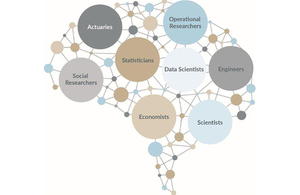Delivering analysis with impact – opportunities and challenges
A blog on the opportunities and challenges of the Analysis Function in government.

Analysis Team Brain image
This year the professional analysts in government are combining their expertise to launch a shared vision for the Analysis Function in government. This follows the clear agreement at the first senior leaders Analysis Function conference that together the analytical professions across government can make more of their successes, challenges, and opportunities.
Despite being a small professional group, the Government Actuary’s Department (GAD) has a big role to play in supporting the vision to deliver better outcomes through analysis. This was shown at the Analytical Function Conference (PDF, 549KB) when Evie Calcutt and I presented GAD’s work to support developing countries make informed decisions on climate risk management (PDF, 1.48MB).
A shared challenge
Actuaries, like other professional analysts, need to communicate analytical concepts clearly to non-analysts. The climate change risk management work highlights the challenges of clear communication of technical concepts and understanding of those concepts. To integrate analysis and critical thinking into government we need everyone to think about concepts like:
- Variability and extremes: Presenting and considering the implications of more than just the most likely or average scenario.
- Dealing with and presenting uncertainty: Providing meaningful analysis even if it’s very sensitive to uncertain assumptions with limited data.
- Non-linearity: Appreciating underlying drivers might have “cliff” effects. For example, a 0.1 degree difference in climate potentially resulting in catastrophic differences like certain species becoming extinct.
- Timeframes: Balancing the impact of outcomes predicted by long-term analysis vs. the shorter term political priorities.
- Interdependencies and correlation: Commissioners of analysis can focus on one risk at a time, assuming that risks are independent which can be a simplification.
Communication, communication, communication to build analytical capability
From the discussions I have had with other analytical professionals, it is clear that these challenges apply more broadly across many areas of analysis in government. So how do we actually solve the them? I suspect there isn’t a magic solution. However, actuaries recognise the magnitude of the challenge and dedicate significant effort towards addressing it – as a department and a profession. By collaborating with the other analytical professions, hopefully we can communicate more effectively than the sum of our parts.
The actuarial profession focuses on communication as one of the key skills of an actuary. It features prominently in the actuarial exam program, the ongoing requirements for continuing professional development, and our professional standards. At GAD, actuaries access a variety of internal training on communication and other soft skills and the emphasis on communication starts right at entry level. Can our analytical colleagues learn from us, and can we learn from them? The more effective we are in communicating our analysis the greater analytical capability we will build outside of our Function.
Common challenges, different insights - opportunities to collaborate
We have a lot in common across the Analysis Function, and each profession can bring useful insights such that we all clearly benefit from working together.
Each profession, including GAD, is committing a range of representatives to support the Analysis Function. We are working to support better decision making, share professional standards, manage talent, and build exciting and varied careers. With each initiative, the conversations generate more discussions of how our common goal for analysis to deliver better outcomes we identify provides more opportunities to collaborate. Personally, I am excited at the potential for learning from other professions as well as the work on loans/secondments within the Function.
Anna Edwards, Actuary, Government Actuary’s Department